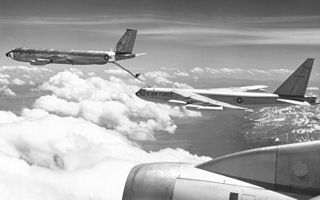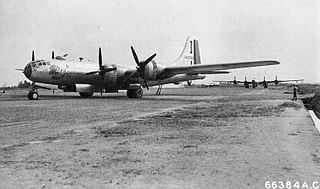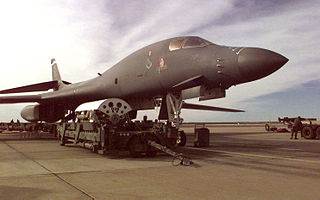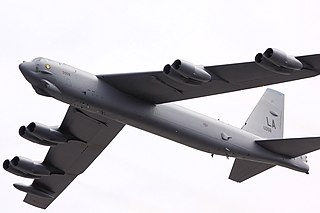
The 499th Air Refueling Wing is an inactive United States Air Force (USAF) unit that was last active at Westover AFB, Massachusetts in June 1966.

The 462d Air Expeditionary Group is a provisional unit of the United States Air Force. It is assigned to Air Mobility Command to activate or inactivate as needed to meet operational requirements. Its last assignment was at Naval Support Facility Diego Garcia, British Indian Ocean Territory.

The 346th Bombardment Group is a former United States Army Air Forces unit. It was last assigned to the 316th Bombardment Wing at Kadena Airfield, Okinawa, where it was inactivated on 30 June 1946. The group was originally a heavy bomber training unit, but was inactivated in a general reorganization of Army Air Forces training units in 1944. It was reorganized as a Boeing B-29 Superfortress group later that year. It moved to Okinawa in 1945, but arrived too late to participate in combat.

The 6th Attack Squadron is an active United States Air Force unit, assigned to the 49th Wing at Holloman Air Force Base, New Mexico. The squadron is a formal training unit for crews learning to operate unmanned aerial vehicles.

The 2d Bombardment Squadron is an inactive United States Air Force unit. Its last assignment as a Boeing B-52 Stratofortress squadron was with the Strategic Air Command 22d Bombardment Wing stationed at March Air Force Base, California. It was inactivated on 1 October 1982. The unit was redesignated as the 2d Strategic Squadron as a Boeing KC-135 Stratotanker rotational squadron with the 306th Strategic Wing and was last active at RAF Mildenhall, England in 1992.

The 45th Bombardment Squadron is an inactive United States Air Force unit. Its last assignment was with the 40th Bombardment Wing, based at Forbes Air Force Base, Kansas. It was inactivated on 1 September 1964.

Piardoba Airfield is an abandoned airfield in India, located 6.6 miles (10.7 km) S of Bishnupur, West Bengal, Bankura District in the state of West Bengal, India.

The 769th Bombardment Squadron is a former United States Army Air Forces unit. It was last assigned to the 462d Bombardment Group at MacDill Field, Florida, where it was inactivated on 31 March 1946. The squadron was first activated in 1943, and became one of the earliest Boeing B-29 Superfortress units. It moved to the China Burma India Theater in April 1944 and participated in the first attack on the Japanese Home Islands since the 1942 Doolittle Raid on 15 June 1944. It earned three Distinguished Unit Citations. The squadron moved to Tinian with the rest of the 58th Bombardment Wing in April 1945 and continued its participation in the strategic bombing campaign against Japan until V-J Day. In November 1945, it returned to the United States, where it was inactivated in April 1946.

The 770th Bombardment Squadron is a former United States Army Air Forces unit. It was last assigned to the 462d Bombardment Group at MacDill Field, Florida, where it was inactivated on 31 March 1946. The squadron was first activated in 1943, and became one of the earliest Boeing B-29 Superfortress units. It moved to the China Burma India Theater in April 1944 and participated in the first attack on the Japanese Home Islands since the 1942 Doolittle Raid in June 1944. It earned its three Distinguished Unit Citations. The squadron moved to Tinian with the rest of the 58th Bombardment Wing in April 1945 and continued its participation in the strategic bombing campaign against Japan until V-J Day. In November 1945, it returned to the United States, where it was inactivated.
The 771st Bombardment Squadron is a former United States Army Air Forces unit. The squadron was activated in 1943, and became one of the earliest Boeing B-29 Superfortress units. It moved to the China Burma India Theater in April 1944 and participated in the first attack on the Japanese Home Islands since the 1942 Doolittle Raid in June 1944. In August 1944, it earned a Distinguished Unit Citation. It was inactivated on 12 October 1944, when the Army Air Forces reorganized its very heavy bomber groups to consist of three, rather than four squadrons.

The 24th Expeditionary Reconnaissance Squadron is a provisional unit of the United States Air Force. It is assigned to United States Air Forces Europe to activate or inactivate as needed. Its last known attachment was to the 100th Air Refueling Wing, stationed at RAF Mildenhall, Suffolk, UK in 2007.

The 676th Bombardment Squadron is a former unit of the United States Army Air Forces, last assigned to the 444th Bombardment Group at Davis-Monthan Field, Arizona.

The 345th Bomb Squadron is a United States Air Force Reserve squadron, assigned to the 489th Bomb Group. It is stationed at Dyess Air Force Base, Texas, where it is an associate unit of the 7th Bomb Wing.

The 920th Air Refueling Squadron is an inactive United States Air Force unit. It was last assigned to the 379th Bombardment Wing at Wurtsmith Air Force Base, Michigan where it was inactivated on 30 September 1992.

The 41st Expeditionary Air Refueling Squadron is a provisional United States Air Force unit. It was last assigned to the 380th Operations Group at Griffiss Air Force Base, New York, where it was inactivated on 15 February 1993.

The 62d Bombardment Squadron is an inactive United States Air Force unit. It was last assigned to the 2d Operations Group at Barksdale Air Force Base, Louisiana on 18 January 1993.

The 421st Air Refueling Squadron is an inactive United States Air Force unit. It was last assigned to the 41st Air Division at Yokota Air Base, Japan, where it was inactivated on 18 February 1965.

The 782nd Tactical Air Support Training Squadron is an inactive United States Air Force unit. The squadron's most distinguished predecessor is the 792nd Bombardment Squadron, which was organized in 1943 as one of the first Boeing B-29 Superfortress units, The squadron participated in the strategic bombing campaign against Japan, earning three Distinguished Unit Citations. It returned to the United States following V-J Day and briefly became one of the first units in Strategic Air Command before inactivating at the end of March 1946.

The 793d Bombardment Squadron is a former United States Army Air Forces unit. The squadron was organized in 1943 as one of the first Boeing B-29 Superfortress units. After training in the United States, The squadron moved to India and participated in the strategic bombing campaign against Japan. When bases in the Mariana Islands became available, the squadron moved to Tinian, where it was able to strike targets in Japan without staging through forward bases. It earned three Distinguished Unit Citations during its combat tour. It returned to the United States following V-J Day and briefly became one of the first units in Strategic Air Command before inactivating at the end of March 1946.

The 795th Bombardment Squadron is a former United States Army Air Forces unit. The squadron was organized in 1943 as one of the first Boeing B-29 Superfortress units. After training in the United States, The squadron moved to India and participated in the strategic bombing campaign against Japan, earning a Distinguished Unit Citation before being disbanded on 12 October 1944 when the Army Air Forces reorganized its very heavy bomber groups to consist of only three squadrons.























